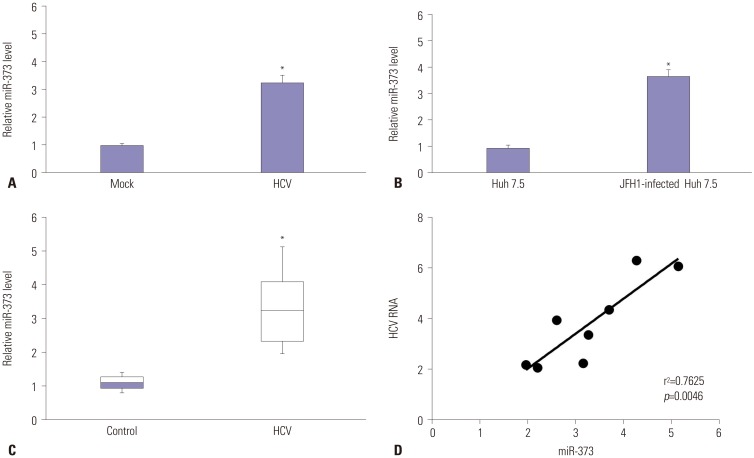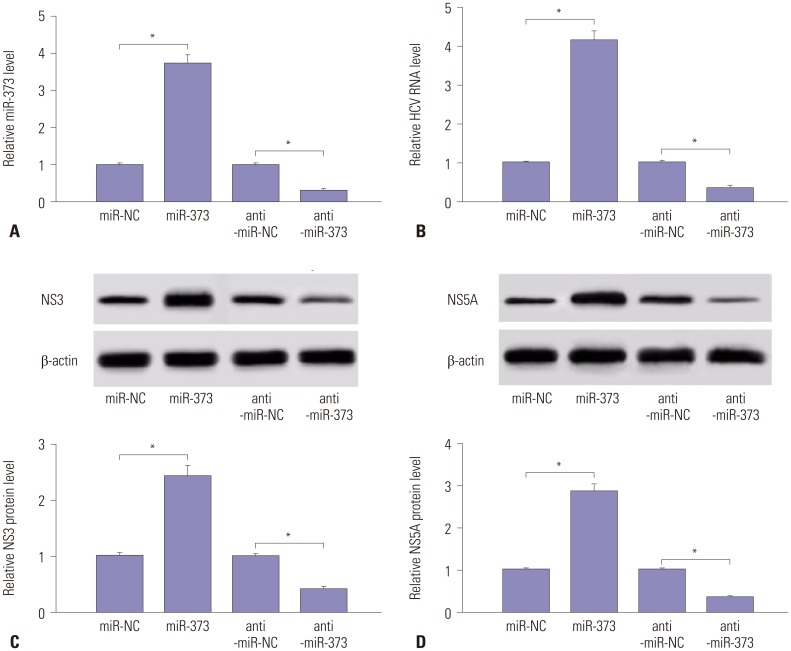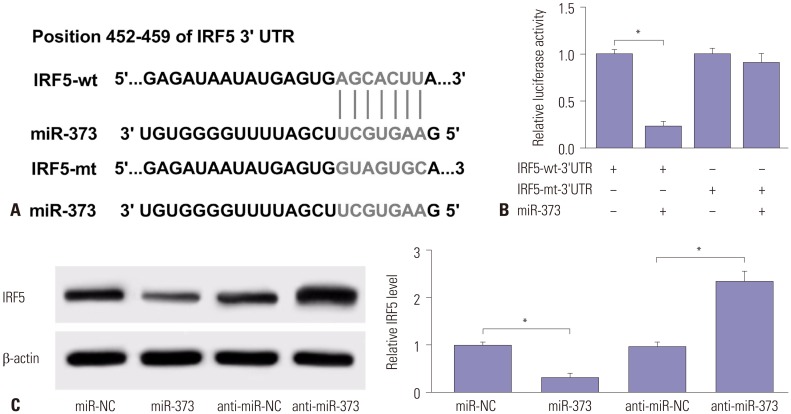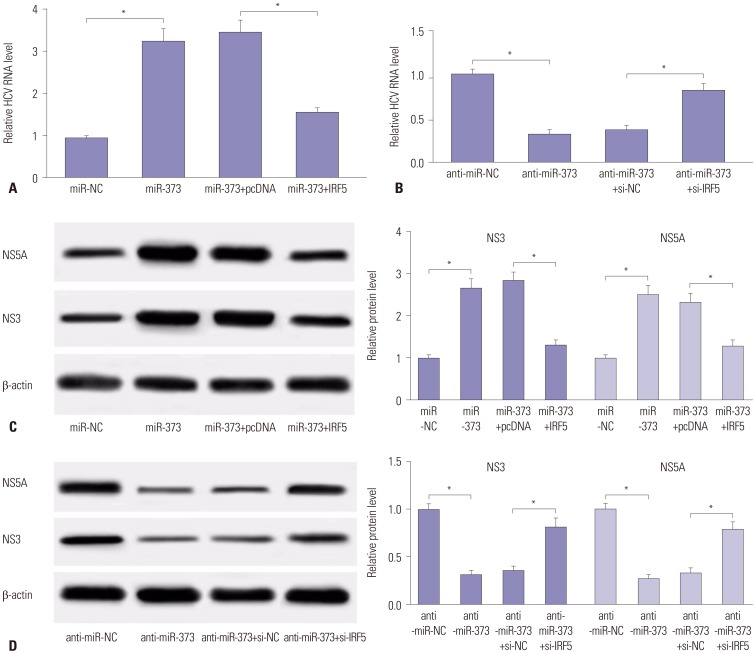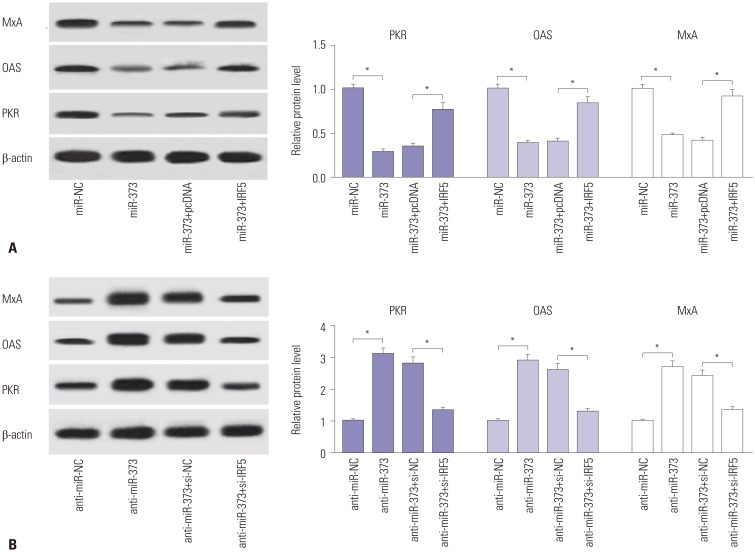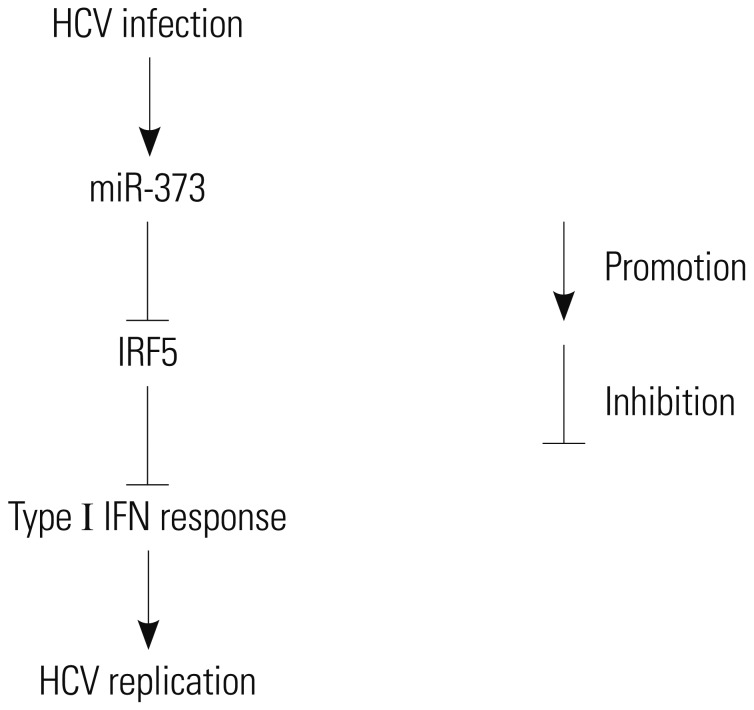Yonsei Med J.
2018 Dec;59(10):1181-1189. 10.3349/ymj.2018.59.10.1181.
Depletion of MicroRNA-373 Represses the Replication of Hepatitis C Virus via Activation of Type 1 Interferon Response by Targeting IRF5
- Affiliations
-
- 1Department of Blood Transfusion, Xi'an Central Hospital, Xi'an, China. qianl4587963@sina.com
- 2Hematological Research Institute, Xi'an Central Hospital, Xi'an, China.
- KMID: 2426332
- DOI: http://doi.org/10.3349/ymj.2018.59.10.1181
Abstract
- PURPOSE
Hepatitis C virus (HCV) poses a risk of chronic liver disease and threatens a significant number of people worldwide. MicroRNAs (miRNAs) are linked to the regulation of hepatocarcinogenesis. Although miR-373 is required for HCV infection, the underlying mechanisms of miR-373 involvement in HCV replication remain elusive.
MATERIALS AND METHODS
Quantitative reverse transcription PCR assays were performed to detect the abundances of miR-373 and HCV RNA either in Huh 7.5 cells or liver biopsy specimens with HCV infection. Luciferase assay was employed to probe the interactions between miR-373 and interferon regulatory factor 5 (IRF5). Western blot was conducted to investigate the effect of miR-373 and IRF5 on HCV replication and activation of type 1 interferon (IFN) response in JFH1-infected Huh 7.5 cells.
RESULTS
HCV infection appeared to be caused by increased miR-373 expression. Addition of miR-373 promoted HCV RNA expression, while miR-373 depletion led to an inhibitive effect on HCV replication. Concordantly, IRF5, as a direct target, was limited by miR-373 in JFH1-infected Huh 7.5 cells. In addition, introduction of IRF5 protected HCV replication in the presence of abundant miR-373. Furthermore, the miR-373-mediated inhibitory effect on type 1 IFN response was ablated following IRF5 accumulation.
CONCLUSION
miR-373 abrogation reduced HCV replication via activation of type 1 IFN responses by targeting IRF5 in JFH1-infected Huh 7.5 cells, suggesting a promising therapeutic for treating HCV infection.
Keyword
MeSH Terms
Figure
Reference
-
1. Maasoumy B, Wedemeyer H. Natural history of acute and chronic hepatitis C. Best Pract Res Clin Gastroenterol. 2012; 26:401–412. PMID: 23199500.2. Bartenschlager R, Lohmann V, Penin F. The molecular and structural basis of advanced antiviral therapy for hepatitis C virus infection. Nat Rev Microbiol. 2013; 11:482–496. PMID: 23748342.
Article3. Webster DP, Klenerman P, Dusheiko GM. Hepatitis C. Lancet. 2015; 385:1124–1135. PMID: 25687730.
Article4. Vojtechova Z, Tachezy R. The role of miRNAs in virus-mediated oncogenesis. Int J Mol Sci. 2018; 19:1217.
Article5. Wong CM, Tsang FH, Ng IO. Non-coding RNAs in hepatocellular carcinoma: molecular functions and pathological implications. Nat Rev Gastroenterol Hepatol. 2018; 15:137–151. PMID: 29317776.
Article6. Israelow B, Mullokandov G, Agudo J, Sourisseau M, Bashir A, Maldonado AY, et al. Hepatitis C virus genetics affects miR-122 requirements and response to miR-122 inhibitors. Nat Commun. 2014; 5:5408. PMID: 25403145.
Article7. Bandiera S, Pfeffer S, Baumert TF, Zeisel MB. miR-122—a key factor and therapeutic target in liver disease. J Hepatol. 2015; 62:448–457. PMID: 25308172.8. Wang H, Gao H, Duan S, Song X. Inhibition of microRNA-199a-5p reduces the replication of HCV via regulating the pro-survival pathway. Virus Res. 2015; 208:7–12. PMID: 26027911.
Article9. Li Q, Lowey B, Sodroski C, Krishnamurthy S, Alao H, Cha H, et al. Cellular microRNA networks regulate host dependency of hepatitis C virus infection. Nat Commun. 2017; 8:1789. PMID: 29176620.
Article10. Mukherjee A, Di Bisceglie AM, Ray RB. Hepatitis C virus-mediated enhancement of microRNA miR-373 impairs the JAK/STAT signaling pathway. J Virol. 2015; 89:3356–3365. PMID: 25589644.
Article11. Cullen BR. MicroRNAs as mediators of viral evasion of the immune system. Nat Immunol. 2013; 14:205–210. PMID: 23416678.
Article12. Zhu H, Geng Y, He Q, Li M. miRNAs regulate immune response and signaling during hepatitis C virus infection. Eur J Med Res. 2018; 23:19. PMID: 29669594.13. Akira S, Uematsu S, Takeuchi O. Pathogen recognition and innate immunity. Cell. 2006; 124:783–801. PMID: 16497588.
Article14. Barth H. Hepatitis C virus: is it time to say goodbye yet? Perspectives and challenges for the next decade. World J Hepatol. 2015; 7:725–737. PMID: 25914773.
Article15. Ye L, Wang S, Wang X, Zhou Y, Li J, Persidsky Y, et al. Alcohol impairs interferon signaling and enhances full cycle hepatitis C virus JFH-1 infection of human hepatocytes. Drug Alcohol Depend. 2010; 112:107–116. PMID: 20646875.
Article16. Kim H, Mazumdar B, Bose SK, Meyer K, Di Bisceglie AM, Hoft DF, et al. Hepatitis C virus-mediated inhibition of cathepsin S increases invariant-chain expression on hepatocyte surface. J Virol. 2012; 86:9919–9928. PMID: 22761382.
Article17. Nandakumar R, Finsterbusch K, Lipps C, Neumann B, Grashoff M, Nair S, et al. Hepatitis C virus replication in mouse cells is restricted by IFN-dependent and -independent mechanisms. Gastroenterology. 2013; 145:1414–1423. PMID: 23973921.18. Cevik O, Li D, Baljinnyam E, Manvar D, Pimenta EM, Waris G, et al. Interferon regulatory factor 5 (IRF5) suppresses hepatitis C virus (HCV) replication and HCV-associated hepatocellular carcinoma. J Biol Chem. 2017; 292:21676–21689. PMID: 29079574.
Article19. Guo H, Liu H, Mitchelson K, Rao H, Luo M, Xie L, et al. MicroRNAs-372/373 promote the expression of hepatitis B virus through the targeting of nuclear factor I/B. Hepatology. 2011; 54:808–819. PMID: 21608007.
Article20. Li CH, Tang SC, Wong CH, Wang Y, Jiang JD, Chen Y. Berberine induces miR-373 expression in hepatocytes to inactivate hepatic steatosis associated AKT-S6 kinase pathway. Eur J Pharmacol. 2018; 825:107–118. PMID: 29477657.
Article21. Wakita T. Isolation of JFH-1 strain and development of an HCV infection system. Methods Mol Biol. 2009; 510:305–327. PMID: 19009271.
Article22. Chen J, Shi X, Zhang X, Wang A, Wang L, Yang Y, et al. MicroRNA 373 facilitates the replication of porcine reproductive and respiratory syndrome virus by its negative regulation of type I interferon induction. J Virol. 2017; 91:e01311–e01316. PMID: 27881653.
Article23. Xie Y, He S, Wang J. MicroRNA-373 facilitates HSV-1 replication through suppression of type I IFN response by targeting IRF1. Biomed Pharmacother. 2018; 97:1409–1416. PMID: 29156530.
Article24. Liao TL, Hsieh SL, Chen YM, Chen HH, Liu HJ, Lee HC, et al. Rituximab may cause increased hepatitis C virus viremia in rheumatoid arthritis patients through declining exosomal microRNA-155. Arthritis Rheumatol. 2018; 70:1209–1219. PMID: 29575671.
Article25. Ahmed CS, Winlow PL, Parsons AL, Jopling CL. Eukaryotic translation initiation factor 4AII contributes to microRNA-122 regulation of hepatitis C virus replication. Nucleic Acids Res. 2018; 46:6330–6343. PMID: 29669014.
Article26. Bartel DP. MicroRNAs: target recognition and regulatory functions. Cell. 2009; 136:215–233. PMID: 19167326.
Article27. Gao F, Zhao ZL, Zhao WT, Fan QR, Wang SC, Li J, et al. miR-9 modulates the expression of interferon-regulated genes and MHC class I molecules in human nasopharyngeal carcinoma cells. Biochem Biophys Res Commun. 2013; 431:610–616. PMID: 23291181.
Article28. Leng RX, Wang W, Cen H, Zhou M, Feng CC, Zhu Y, et al. Gene-gene and gene-sex epistatic interactions of MiR146a, IRF5, IKZF1, ETS1 and IL21 in systemic lupus erythematosus. PLoS One. 2012; 7:e51090. PMID: 23236436.
Article29. Watanabe T, Imamura T, Hiasa Y. Roles of protein kinase R in cancer: potential as a therapeutic target. Cancer Sci. 2018; 109:919–925. PMID: 29478262.
Article30. Malathi K, Paranjape JM, Bulanova E, Shim M, Guenther-Johnson JM, Faber PW, et al. A transcriptional signaling pathway in the IFN system mediated by 2′-5′-oligoadenylate activation of RNase L. Proc Natl Acad Sci U S A. 2005; 102:14533–14538. PMID: 16203993.
Article31. Maria NI, Brkic Z, Waris M, van Helden-Meeuwsen CG, Heezen K, van de Merwe JP, et al. MxA as a clinically applicable biomarker for identifying systemic interferon type I in primary Sjogren's syndrome. Ann Rheum Dis. 2014; 73:1052–1059. PMID: 23831963.32. Li Y, Ye L, Peng JS, Wang CQ, Luo GX, Zhang T, et al. Morphine inhibits intrahepatic interferon-alpha expression and enhances complete hepatitis C virus replication. J Infect Dis. 2007; 196:719–730. PMID: 17674315.33. Rönnblom L. The type I interferon system in the etiopathogenesis of autoimmune diseases. Ups J Med Sci. 2011; 116:227–237. PMID: 22066971.
Article34. Sarasin-Filipowicz M, Krol J, Markiewicz I, Heim MH, Filipowicz W. Decreased levels of microRNA miR-122 in individuals with hepatitis C responding poorly to interferon therapy. Nat Med. 2009; 15:31–33. PMID: 19122656.
Article35. Cheng YQ, Ren JP, Zhao J, Wang JM, Zhou Y, Li GY, et al. MicroRNA-155 regulates interferon-γ production in natural killer cells via Tim-3 signalling in chronic hepatitis C virus infection. Immunology. 2015; 145:485–497. PMID: 25772938.36. Sidorkiewicz M, Grek M, Jozwiak B, Krol A, Piekarska A. The impact of chronic hepatitis C infection on cholesterol metabolism in PBMCs is associated with microRNA-146a expression. Eur J Clin Microbiol Infect Dis. 2017; 36:697–702. PMID: 27888401.
Article37. Bhanja Chowdhury J, Shrivastava S, Steele R, Di Bisceglie AM, Ray R, Ray RB. Hepatitis C virus infection modulates expression of interferon stimulatory gene IFITM1 by upregulating miR-130A. J Virol. 2012; 86:10221–10225. PMID: 22787204.
Article38. Chen Y, Chen J, Wang H, Shi J, Wu K, Liu S, et al. HCV-induced miR-21 contributes to evasion of host immune system by targeting MyD88 and IRAK1. PLoS Pathog. 2013; 9:e1003248. PMID: 23633945.
Article
- Full Text Links
- Actions
-
Cited
- CITED
-
- Close
- Share
- Similar articles
-
- Inhibition of hepatitis B virus replication by RNA interference
- Clinical Outcome of the HBsAg Positive Malignant Lymphoma Patients Following Anticancer Chemotherapy
- Intracellular Antibody Fragment Against Hepatitis B Virus X Protein Does Not Inhibit Viral Replication
- Immunotherapy for Chronic Hepatitis B Virus Infection
- Prevention of Viral Hepatitis and Vaccination

